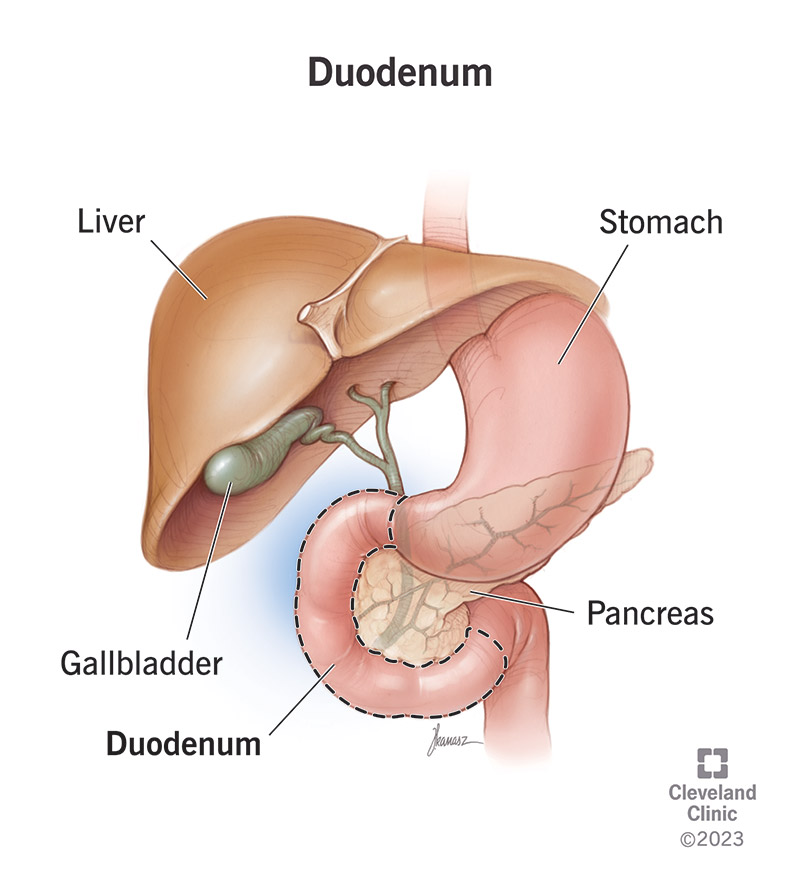The duodenum is the first part of your small intestine. Its main job is to transform the partially digested food it receives from your stomach into nutrients your body can use. Digestive juices from your liver, gallbladder and pancreas empty into your duodenum, helping with digestion and absorption.
Advertisement
Cleveland Clinic is a non-profit academic medical center. Advertising on our site helps support our mission. We do not endorse non-Cleveland Clinic products or services. Policy

The duodenum is the first part of your small intestine. Despite what the name suggests, your “small” intestine is the longest part of your digestive tract and plays a big role in your digestive system. Inside its many coils, digestive juices transform food into the nutrients (like proteins, fats, vitamins and water) that power your body.
Advertisement
Cleveland Clinic is a non-profit academic medical center. Advertising on our site helps support our mission. We do not endorse non-Cleveland Clinic products or services. Policy
The duodenum is a short, “C”-shaped chute. It’s the first stop food makes as it travels from your stomach to your small intestine. The other parts of your small intestine are your jejunum (the middle part) and ileum (the last part).
The duodenum continues the process of digestion (breakdown of food into nutrients) that starts in other parts of your gastrointestinal (GI) tract, like your mouth and stomach. It also begins the absorption process (moving the nutrients into your bloodstream). Think of it this way: Before reaching your duodenum, saliva and stomach acid have transformed food into food slush. Inside your duodenum, the slush becomes nutrients your body can use.
Your duodenum:
Advertisement
It’s the shortest section of your small intestine, approximately 10 inches long — just 2 inches shy of a foot. “Duodenum,” translated from Latin, means “12 fingers,” a reference to its size. The length of your duodenum is approximately the width of 12 fingers placed side by side.
To put this in perspective, your entire small intestine is 22 feet long. If you stretched it out, it would be the length of a tennis court. Your duodenum wouldn’t be a single foot of the total length. Yet, important nutrient absorption happens in these 10 inches of your small intestine.
Your duodenum starts just below your stomach. It curves to the right and back, down and then to the left in a “C” or horseshoe shape. It slants upward slightly before joining with the next part of your small intestine, your jejunum. The head of your pancreas (the widest part) sits inside the “C.”
There are four basic parts. They get their name from their location and shape.
The superior segment is the top part of the duodenum that connects with your stomach. It’s about 2 inches long. The part of the superior segment that connects directly with your pylorus (the stomach valve that opens to allow food to travel to your small intestine) is called the duodenal bulb. Most ulcers in your small intestine form here, where stomach acid is most likely to come into contact with your duodenum.
As the name suggests, the descending segment is the part of the “C” shape that goes downward. It passes in front of your right kidney and is about 4 inches long.
This part of your small intestine connects to your pancreas (via the pancreatic duct) and your gallbladder and liver (via the common bile duct). “Ducts” are like tiny canals that allow substances to travel from one organ (like your liver) to another organ (like your small intestine). These organs produce substances that empty into the descending segment, breaking down fats, proteins and carbohydrates.
The horizontal segment is about 4 inches long. It extends from right to left and passes over essential blood vessels, including your aorta and inferior vena cava.
This is the smallest part of your duodenum, at just under an inch. It extends slightly upward and is located to the left of your aorta. It connects to your jejunum.
The duodenum has four layers. Its cell makeup is the same as other organs in your GI tract. From the innermost layer to the outermost layer, the duodenum consists of the:
Advertisement
As the part of your small intestine closest to your stomach, your duodenum is especially susceptible to injury if you have excess stomach acid. The acid can lead to open stores in your stomach (peptic ulcers) and in your duodenum. The most common causes of these ulcers are H. pylori infection and overusing medicines called NSAIDs (nonsteroidal anti-inflammatory drugs). NSAIDs, like aspirin and ibuprofen, can ease symptoms like aches and pains but can cause ulcers if you use them too much.
If an untreated ulcer breaks down too much of your duodenum’s protective barrier, its contents can leak out and damage the gastroduodenal artery behind it. This can cause severe bleeding that requires emergency care.
Many of the same conditions that affect your small intestine, in general, can affect your duodenum specifically. Conditions that can affect your duodenum include:
Advertisement
Symptoms depend on the specific condition. In general, symptoms of a condition affecting your duodenum are similar to problems with your GI tract. Signs and symptoms include:
Common tests include:
Common treatments include:
Putting healthy habits into place to prevent irritating or overworking your digestive system is good for your entire GI tract, including your duodenum.
Advertisement
Your digestive system helps you digest (break down) food, absorb nutrients and move the leftover waste from your body. Although it’s only a tiny part of this system, your duodenum plays a key role in two of those functions: digestion and absorption. Take care of your duodenum by taking care of your digestive health. Feed your body nutrient-rich foods that your duodenum can help you digest, absorb and use.
Last reviewed on 05/24/2024.
Learn more about the Health Library and our editorial process.